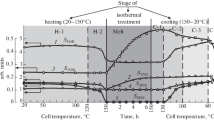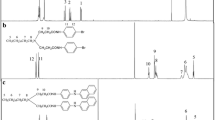Abstract
Polymers undergo oxidation reactions when heated in air. Heating of the polymer takes place at any stage of the life of the polymer, e.g. during polymerization, processing or end use of the ready product. Oxidation results in chain scission, branching, crosslinking or formation of oxygen-containing functional groups and leads to deterioration of physical properties and discoloration of the polymer. Antioxidants are added at low concentrations during production or processing of polymers to minimize the adverse effects of thermo-oxidation. Now that recycling of post-consumer polymers is of increasing importance, the use of antioxidants is a good way to avoid deterioration of physical properties and discoloration of the polymer during reprocessing.
Access this chapter
Tax calculation will be finalised at checkout
Purchases are for personal use only
Preview
Unable to display preview. Download preview PDF.
Similar content being viewed by others
References
Buxbaum, L.H. (1968) The Degradation of Poly(ethylene terephthalate), Angew. Chem. Intern. Edit., 7(3), 182–290.
Solera, P. (1993) Stabilization and Color Enhancement of Virgin and Reprocessed PET, SPE RETEC Proceedings, October 11–13, 1993, Orlando, FL, 161–180.
Zimmerman, H. and Kim, N.T. (1980) Investigations of Thermal and Hydrolytic Degradation of Poly(ethylene terephthalate). Polymer Engineering and Science, 20(10), 680–683.
Pobedimskii, D.G., Kurashov, V.I. and Kirpichnikov, P.A. (1983) Metal Complexes with Ligands — Organic Phosphites as Polyolefin Antioxidants. J. Polym. Sci., Polym. Chem. Ed., 21, 55–66.
Karayannidis, G., Sideridou, I., Zamboulis, D., Stalidis, G., Bikiaris, D. and Wilmes, A. (1994) Effect of Some Current Antioxidants on the Thermo-oxidative Stability of Poly(ethylene terephthalate). Polym. Degr. and Stab., 44, 9–15.
Editor information
Editors and Affiliations
Rights and permissions
Copyright information
© 1998 Springer Science+Business Media Dordrecht
About this chapter
Cite this chapter
Karayannidis, G.P., Sideridou, I.D., Zamboulis, D.X. (1998). Antioxidants for poly(ethylene terephthalate). In: Pritchard, G. (eds) Plastics Additives. Polymer Science and Technology Series, vol 1. Springer, Dordrecht. https://doi.org/10.1007/978-94-011-5862-6_11
Download citation
DOI: https://doi.org/10.1007/978-94-011-5862-6_11
Publisher Name: Springer, Dordrecht
Print ISBN: 978-94-010-6477-4
Online ISBN: 978-94-011-5862-6
eBook Packages: Springer Book Archive




